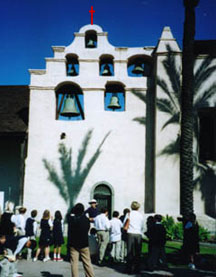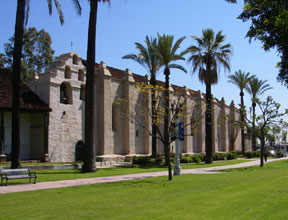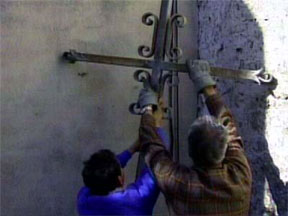| |
A Resource by Mark D. Roberts |
|
The Los Angeles County Cross Controversy
by Rev. Dr. Mark D. Roberts
Copyright © 2004-2006 by Mark D. Roberts
Note: You may download this resource at no cost, for personal use or for use in a Christian ministry, as long as you are not publishing it for sale. All I ask is that you give credit where credit is due. For all other uses, please contact me at mark@markdroberts.com. Thank you.
On the Meaning of a Symbol:
The Los Angeles Cross Controversy, Part 1
Posted at 9:00 p.m. on Friday, June 11, 2004
| I want to weigh in on the controversy surrounding the cross on the county seal of Los Angeles. For those of you who are not familiar with this issue, I’ll summarize briefly. For the last fifty years or so, the County of Los Angeles has had an official seal. It incorporates elements of the history and culture of Los Angeles, including a fish to signify the fishing industry, two stars to represent the entertainment industry, a Spanish galleon to commemorate the explorers who came to California, and a tiny cross to memorialize the early Christian impact on Los Angeles through the Spanish missions. You can see from the seal pictured to the right that the cross is tiny, almost insignificant, and much less prominent than the picture of Pomona, the Roman goddess of the harvest. |
|
| |
The county seal, featuring the goddess Pomona, with a tiny cross on the right side. |
Recently the ACLU threatened the County of Los Angeles with a lawsuit, alleging that the presence of the cross on the county seal violates the constitutional separation of church and state. The ACLU claims that the cross on the seal is an unconstitutional “endorsement of Christianity.” "The question is: will somebody who looks at the seal believe that there's an improper association between the government and one religion?" said Ben Wizner, an attorney with the ACLU of Southern California. "It's about preventing the appearance of religious sponsorship."
Fearing an expensive lawsuit, the Los Angeles County Board of Supervisors voted 3-2 to remove the cross from the seal, and to replace it with some less religious symbol (like a Spanish mission without a cross, which somebody described as a “Taco Bell”). What the Supervisors didn’t expect was the loud outcry from many citizens of Los Angeles, including Jews, Buddhists, and atheists, calling upon the Supervisors to rescind their vote. The protestors argued that the symbol on the seal is not meant to promote Christianity, but simply to commemorate the true history of Los Angeles, in which Christianity played a prominent, even a leading role. (To hear Dennis Prager's stirring speech urging Supervisors not to remove the cross, click here.)
But the Supervisors voted once again to remove the cross and to bow before the imperious threats of the ACLU. This is where the matter stands as of today.
Let me begin my response by saying that, as a Christian, I do not expect the government to promote Christianity. I don’t want the government to promote Christianity. In fact, I think there is great danger for the Christian gospel when the government gets in bed with the church or vice versa. (See, for example, my last post: Who Won? Rome or Christ?)
As a citizen of the United States, however, and as one who lived in LA County for 25 years, I’m very concerned about what the Supervisors have done. I believe that an accurate, truthful, and widely-acknowledged understanding of our history as a people is essential to our health and future. Erasing the cross, even such a tiny one, is an attempt to rewrite history in the image of ideology, not reality.
But I’m also very concerned about the logic behind the ACLU’s action and the County’s reaction. I’m not a legal scholar, so I’m not going to examine this case from a constitutional perspective, but from a logical, moral, and dare I say, common sense perspective.
The ACLU argues that the tiny cross on the county seal appears to sponsor Christianity. They argue, furthermore, that the cross is such an obvious religious symbol that it cannot be seen as otherwise. But I’m not so sure. Certainly in most contexts the cross is a religious symbol. But can’t it be displayed with other primary meanings? The cross was included on the county seal, not to promote any religion, but simply to commemorate the history of Christian influence in Los Angeles. Nobody has argued that the Supervisors who first voted for the county seal had the slightest intention of promoting Christianity (or the worship of the pagan goddess Pomona, for that matter). The fact is that they were using the cross, not as a religious symbol per se, but as an historical symbol. It wasn’t included on the county seal to encourage people to remember the meaning of the death of Jesus or to propagate faith in Jesus, but rather to recall the crucial influence of the Christian missions in the history of Los Angeles county. So, I would argue that the cross in this instance is not a religious symbol so much as an historical symbol. This cross points to the history of Los Angeles, not to the death of Christ and its meaning.
 |
Let me use an analogy to help make my point. Suppose a history textbook used in the public schools sought to tell the story of D-Day. And suppose, further, that this textbook included a photograph of the Normandy American Cemetery, with its over 9,000 crosses on the graves of the soldiers who perished in the invasion. In this case a public school would be displaying an image of a cross (many crosses, actually). Now if the cross is necessarily a religious symbol, then this would be a violation of the Constitution. The ACLU would argue |
that the textbook is promoting Christianity. But I think it’s clear that the textbook includes a picture of crosses, not with religious intent or meaning, but with historical intent and meaning. Yet if we buy the ACLU’s argument, then such a picture should be removed from a public school textbook. (I hesitate to use this analogy because I fear that I might give the ACLU a whole new realm in which to intimate and attempt to rewrite history!)
“But,” an ACLUer might respond, “what if someone takes the cross on the county seal of Los Angeles as a religious symbol, even if it was intended to have a purely historical meaning? What if that someone is offended by the presence of the cross on the county seal? In this case, the cross should be removed.”
This is an important argument, and I will address it in my next post.
Home
On the Tyranny of Feelings:
The Los Angeles Cross Controversy, Part 2
Posted at 10:00 p.m. on Sunday, June 13, 2004
In a recent post I began to address the controversy over the cross on the seal of Los Angeles County. I argued that sometimes a religious symbol can be used non-religiously, and therefore to include such a symbol on a public seal would not be promoting one particular religion. The cross on the county seal is obviously meant signify historical events in Los Angeles, not to promote religious faith. In this case, I would argue, the cross is not a religious symbol so much as an historical symbol.
Of course the ACLU is not be inclined to make such careful logical distinctions. "The question is: will somebody who looks at the seal believe that there's an improper association between the government and one religion?" said Ben Wizner, an attorney with the ACLU of Southern California. "It's about preventing the appearance of religious sponsorship."
So, Wizner argues, the intent of those who designed and adopted the seal doesn’t matter. The way the vast majority of people understand the seal doesn’t matter. What matters is if somebody believes “there’s an improper association between the government and one religion.”
Somebody? One person? Or do we need several somebody’s? And what if that somebody is simply confused about the meaning? Should we cater to the ignorance of that person? Or should we rather help that person to understand the purpose and meaning of the cross on the seal?
Returning to my analogy from the previous post, suppose a non-Christian student in a public school used the textbook that included pictures of the cross on the graves in the Normandy American Cemetery. And suppose this student was offended and complained to school officials: “This textbook is promoting Christianity. I’m offended. The picture should be removed.” Should the school officials bow to this student's feelings? Or should they rather explain the truth to the student: “Actually, the point of the picture is not to promote Christianity, but to help you understand something about history. You should not be offended. The picture will not be removed.” I vote for option #2.
Let’s play out the ACLU’s “somebody thinks there’s an improper association between the government and one religion” argument a bit more. What if somebody believes that the prominent placement of the pagan goddess Pomona on the seal is “an improper association between the government and one religion”? What if somebody thinks that Pomona’s presence endorses paganism? Should the county be compelled to remove Pomona as well? Should we give somebody that much power?
The ACLU showed its true colors after the Board of Supervisors voted for the second time to remove the cross. “The board has shown leadership in the truest sense," said ACLU lawyer Ben Wizner. "The board is not ignoring or erasing the county's history. [Huh?!] It's honoring that history without making some residents feel unwelcome." Here’s the bottom line for the ACLU: not wanting some residents of LA County to feel unwelcome.
But let’s examine this argument a bit further. First of all, I wonder how many residents of LA County have actually been made to feel unwelcome by the presence of a cross on the county seal. One? Ten? A hundred?
Let’s suppose for the sake of argument that the answer is 1,000 (which I imagine to be greatly inflated). Does this mean the county should remove the cross because 1,000 people feel unwelcome? If so, what if 1,000 Christians now feel unwelcome in Los Angeles County because the cross was removed while the pagan goddess was preserved? Or what if religious pagans now feel unwelcome in LA because the County apparently doesn’t take their religion seriously enough to remove the goddess from the seal? Whose feelings count the most? Whose feelings should rule the day?
| I find it hard to believe that many real people were offended by the cross on the county seal. “Ah, but you’re a Christian,” you might respond, “You don’t understand.” Well, let me propose an analogy. Suppose I emigrated to Pakistan and made my permanent residence there. The Pakistani flag features a prominent star and crescent, a symbol of Islam. Would I be offended by this? Hardly. I’d realize that I had moved to a country with a strong Muslim population and history. That’s part of what it would mean to live in Pakistan. Thus I’d be a fool to |
|
feel unwelcomed by the star and crescent symbol, even if it were actually meant to promote Islam. (I don’t know what the Pakistani government intends by the use of the Muslim symbol. I just know I’d be foolish to be offended by it.)
Thus, if there actually were someone who was offended by the cross on the LA county seal, the county’s first response should be to help that person understand the correct meaning of the cross. It’s not promoting Christianity, but reminding us of part of our history. If the person continued to be offended, then it would be best to tell that person kindly to get over it. “Christianity is a central part of LA county history,” the Supervisors should say, “and, whether you like it or not, this is not something we intend to erase. Living here in Southern California involves acknowledging our history and its symbols.”
Many critics of the ACLU have alleged that the organization has a strong anti-Christian bias. This may well be true, and may well help to explain the ACLU’s unreasonable behavior. But the comments by Ben Wizner also demonstrate that the ACLU has its own religion, the religion of feelings. If one person is offended by something, even if that person doesn’t have good reasons for being offended, then that person’s feelings trump reason. The problem with the tyranny of feelings, apart from its denigration of logic, is that people’s feelings will be all over the map. Leave the cross on the seal, and, theoretically at least, somebody might feel unwelcome. Take the cross off the seal but leave the pagan goddess, and others will feel unwelcome. Who’s to say, in the end, which feelings should count the most?
And what if somebody is offended by the very name of the county of Los Angeles, which means in Spanish, “The Angels.” Doesn’t this name have strong religious connotations? Moreover, the historic name of the city (and county) comes from the title “El Pueblo de la Reina de Los Angeles,” which enthrones the Virgin Mary as the Queen of the Angels. I’m sure I could stir up a bunch of conservative Christians who would be offended by the patently Roman Catholic connotations of “Los Angeles,” not to mention others who don’t believe in angels. I could stir up a bunch of people to be offended, but I wouldn’t, because it would be foolish, and life’s too short to invest in folly.
Home
A New Seal for Los Angeles County?
Part 3 in series “The Los Angeles Cross Controversy”
Posted at 9:30 p.m. on Friday, September 17, 2004
Back in June the ACLU threatened to sue Los Angeles County because the county seal included a tiny cross. According to the ACLU, this was an unacceptable mixing of church and state. According to all the sane people, however, the miniscule cross on the county seal was simply a representation of the role of the Spanish missions in Los Angeles County. It was meant as a historical symbol, not a promotion of Christianity. Nevertheless, the threat of a lawsuit from the ACLU intimidated the L.A. Board of Supervisors, who voted to change the seal.
When news broke of the Board’s action, all hell broke loose. Angelenos of all religious stripes – and no religious stripes whatsoever -- were outraged. They saw the Board as capitulating to the Orwellian scare tactics of the ACLU. Moreover, they resented the attempt to rewrite history in order to satisfy a few people with a revisionist political agenda. Yet, in spite of protests and angry letters, the Board of Supervisors sustained its vote to change the seal.
I did some blogging on this issue in June, arguing that the cross on the seal was in no way a promotion of Christianity, but simply a tiny reminder of L.A.’s real history. Every time you see a cross symbol it doesn’t mean that somebody’s trying to get you to believe in Jesus. If a history text book shows a picture of the Normandy American Cemetery, for example, with its field full of crosses, the book isn’t commending Christianity, but teaching history. So I thought, and continue to think, that the Board of Supervisors is doing something both silly and sad. I wish they’d tell the ACLU to get a life.
But, in defense of the Board, I understand that they’re rightly concerned about the financial cost of a lawsuit, even a frivolous one. In a time when Los Angeles County is hurting financially, I can see why the Board isn’t eager to take on the ACLU. Intimidation, in this case, has worked, I’m sad to say. (What a glorious display of civil liberties in America!)
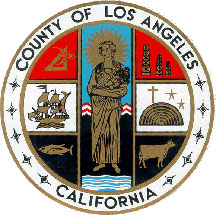 |
The Board recently released the design of the proposed new seal. I want to comment on this new design. Even though I wish the Board would stand up to the ACLU and keep the original seal, I must admit that the new seal is quite clever. Let me explain why. |
|
The old seal |
The new seal |
Most of the old seal remains intact, including the drafting tools, the Spanish galleon, the fish, and the cow. (Sorry about that, vegans!) Only three panels are changed. The oil derricks have been banished to county seal Siberia. (Sorry about that, oil industry!) They are replaced with the symbols of Hollywood (the shell of the Hollywood Bowl and two stars). In the space these symbols once shared with the tiny cross there is now a building. It’s a rather odd looking building, which most people would not be able to identify without help. In fact it’s a tiny image of the San Gabriel mission, one of the Spanish missions in L.A. County.
Of course there’s no cross pictured on this mission. But here’s part of what I find so clever. The artist didn’t remove the cross from the mission. Rather he used a view of the mission that doesn’t include a cross. So, those wishing to defend the new seal could argue that it contains, not a symbol of Christianity in general, but a specific image of a real mission in Los Angeles County. Opponents would argue that the building on the seal is unrecognizable as a mission unless one happened to live down the street from the San Gabriel mission.
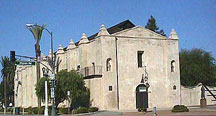 |
|
The picture above is the San Gabriel Mission from the back, like what is proposed for the new county seal. Notice that there is no visible cross on this side. The picture to the right shows the front of this mission. The small cross above the bells is hard to see in this picture, so I highlighted it in red. In reality it is dark gray
|
The other major change from the old seal to the new seal involves replacing the Roman goddess Pomona with a drawing of a Native American woman holding a basket. Pomona, not exactly a major player in the Roman pantheon, was the goddess of the harvest. The Native American woman taking her place holds a large basket, presumably signifying agricultural fruitfulness.
The change from Roman goddess to Native American is also clever, because it undercuts one of the major criticisms of the action of the Board of Supervisors: “They’re taking off the cross, but their leaving the large figure of a pagan goddess. This is a clear case of a bias against Christianity, as well as an insulting belittling of pagan religion.” The removal of Pomona from the seal makes this criticism moot. Moreover, highlighting the presence of a Native American woman is a brilliant move, in that it reflects the genuine history of Los Angeles County, in which local tribes once flourished.
Ironically, all of this fuss about the tiny cross has probably raised awareness of the Christian history of Los Angeles. Now I’m just waiting for someone to protest that the Spanish-Catholic mission movement was an instance of religious and cultural imperialism, and that putting a mission on the seal is actually worse than a generic cross. Moreover, PETA must surely be unhappy with a seal that continues to represent the eating of helpless fish and cattle. So who knows where all of this will end up?
Home
The San Gabriel Mission and the Cross: Strange Ironies 
Part 4 of series The Los Angeles County Cross Controversy 
Posted for Friday, April 21, 2006
A couple of years ago there was a major controversy in Los Angeles when, threatened by the ACLU, the Los Angeles County Board of Supervisors voted to change the county seal, taking off a Christian cross that had represented the historic Catholic missions of the county, and replacing the cross with a cross-less image of the San Gabriel Mission. I weighed in on the controversy myself in a three-part blog series. As a Christian I wasn't particularly offended by the removal of the cross, but as a person who cares about actual history rather than political-correctness run amuck, I found the Board of Supervisors' action to be unnecessary and unhelpful.
The mission now adorning the county seal looks rather more like a barn than a Christian church, though it accurately depicts the south side of the mission building. It has no cross, partly because that side of the San Gabriel Mission is actually cross-less. I was not aware until recently, however, that this mission once had a much larger and more visible cross, though not on the side represented on the seal. This cross was removed from the top of the mission in 1987, in the aftermath of the Whittier Narrows Earthquake, in which the mission sustained significant damage. For seventeen years the cross lived happily in the gardens of the mission. But then, in December of 2004 the cross mysteriously disappeared. (No, there's no truth to the rumor that is was stolen by the ACLU. They just didn't want it on the county seal.)
Last Thursday I found myself in San Gabriel with a few extra minutes so I went to visit the mission. In the parking lot by the front door I saw a news van from a local television news program. I figured I knew what the story was about, because only the day before a fourth effort to get the county seal issue on the ballot had failed. I figured the news crew was going to shoot their story from the San Gabriel Mission, since it now adorns the county seal.
But, as it turns out, I was wrong. In fact the news team was at the mission to film a story about the return of the missing cross. It had been found decorating a patio in nearby Pasadena. The owner of the patio was arrested, accused of possessing stolen property. Meanwhile, the cross was returned to the mission, in Holy Week, no less. I just happened to be there at just the right time.
There's no word yet on whether the mission will return the cross to its original location, still safely away from the side of the mission on the county seal. If the mission priests wanted to stir the pot a bit, they could always mount the cross on the county seal side, thus making the seal inaccurate, and getting everybody all worked up about the cross on the seal again. I rather doubt this will happen, however, and I wouldn't recommend it. Nevertheless, I'm glad the cross is back where it belongs. After being kicked off the county seal, at least it was welcomed home at the mission. |
|
|
The new Los Angles County Seal
|
|
The San Gabriel Mission (the cross-less side)
|
|
The side of the mission. You can see a tiny cross on the left between the two palm trees. That's where the larger one used to be.
|
|
The stolen cross finds its way home.
|
|











